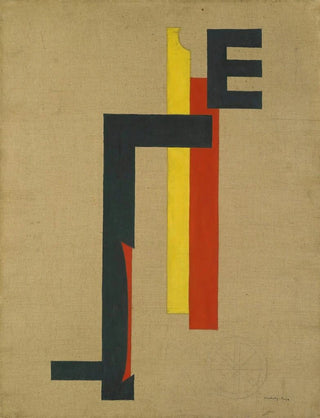Art print | EBild E Image - László Moholy-Nagy


View from behind

Frame (optional)
Art print EBild E Image - László Moholy-Nagy – Captivating Introduction
László Moholy-Nagy's "EBild E Image" is much more than a simple visual representation; it embodies a profound reflection on the relationship between art and technology. In this work, the artist, an iconic figure of the Bauhaus, explores the possibilities offered by the new media of his time, while questioning traditional aesthetic conventions. By contemplating this piece, the viewer is invited to immerse themselves in a universe where light, form, and movement converge, creating an immersive experience that transcends time and space. The art print EBild E Image - László Moholy-Nagy allows us to appreciate this avant-garde vision within our interiors, offering a gateway to an enriching artistic dialogue.
Style and uniqueness of the work
Moholy-Nagy's style is distinguished by its boldness and innovation. "EBild E Image" is characterized by a dynamic use of lines and geometric shapes, where each element appears to be in motion, challenging the viewer's usual perceptions. The piece plays with light and shadow, creating striking contrasts that capture the eye and stimulate the mind. This approach, blending abstraction and figuration, is emblematic of the modernist movement, but it goes even further by incorporating elements of photography and collage. The artist's technique, which merges various mediums, demonstrates his desire to explore the boundaries of art and push the limits of creativity. Thus, "EBild E Image" stands as a visual manifesto, an invitation to reconsider our relationship with image and reality.
The artist and his influence
László Moholy-Nagy, born in 1895 in Hungary, is one of the most influential figures of the 20th century in the fields of art and design. His journey, marked by experiences at the Bauhaus, shaped his unique vision, where art, architecture, and design converge. Moholy-Nagy always advocated the idea that art should be accessible to all and integrated into daily life. His passion for new technologies and his interest in photography opened the

Matte finish

View from behind

Frame (optional)
Art print EBild E Image - László Moholy-Nagy – Captivating Introduction
László Moholy-Nagy's "EBild E Image" is much more than a simple visual representation; it embodies a profound reflection on the relationship between art and technology. In this work, the artist, an iconic figure of the Bauhaus, explores the possibilities offered by the new media of his time, while questioning traditional aesthetic conventions. By contemplating this piece, the viewer is invited to immerse themselves in a universe where light, form, and movement converge, creating an immersive experience that transcends time and space. The art print EBild E Image - László Moholy-Nagy allows us to appreciate this avant-garde vision within our interiors, offering a gateway to an enriching artistic dialogue.
Style and uniqueness of the work
Moholy-Nagy's style is distinguished by its boldness and innovation. "EBild E Image" is characterized by a dynamic use of lines and geometric shapes, where each element appears to be in motion, challenging the viewer's usual perceptions. The piece plays with light and shadow, creating striking contrasts that capture the eye and stimulate the mind. This approach, blending abstraction and figuration, is emblematic of the modernist movement, but it goes even further by incorporating elements of photography and collage. The artist's technique, which merges various mediums, demonstrates his desire to explore the boundaries of art and push the limits of creativity. Thus, "EBild E Image" stands as a visual manifesto, an invitation to reconsider our relationship with image and reality.
The artist and his influence
László Moholy-Nagy, born in 1895 in Hungary, is one of the most influential figures of the 20th century in the fields of art and design. His journey, marked by experiences at the Bauhaus, shaped his unique vision, where art, architecture, and design converge. Moholy-Nagy always advocated the idea that art should be accessible to all and integrated into daily life. His passion for new technologies and his interest in photography opened the






